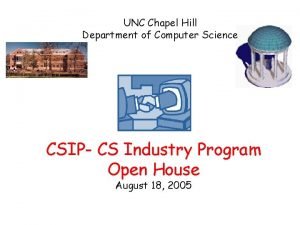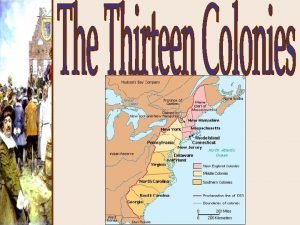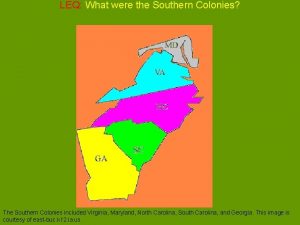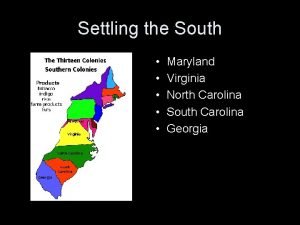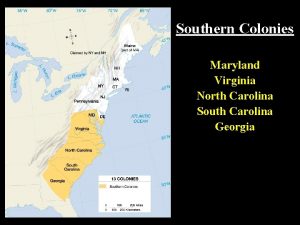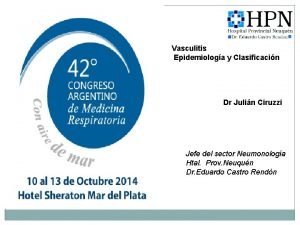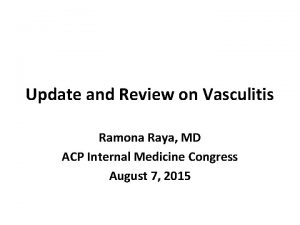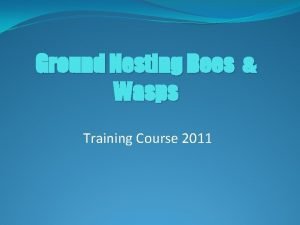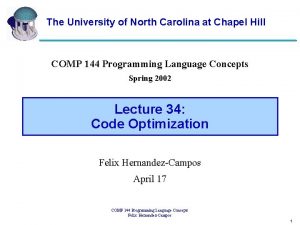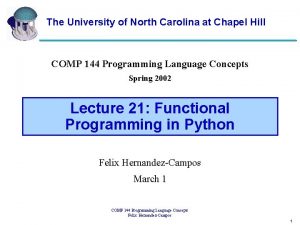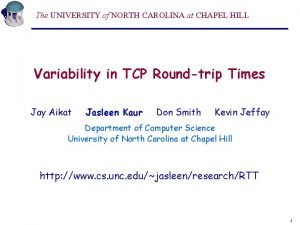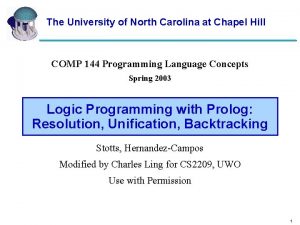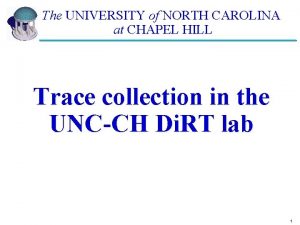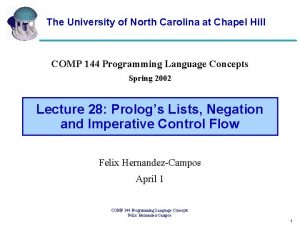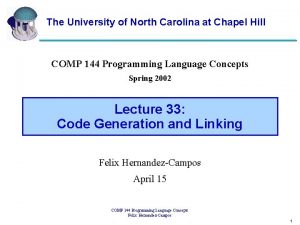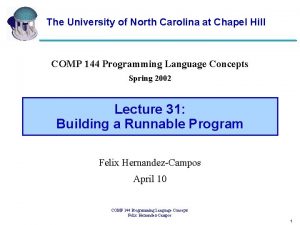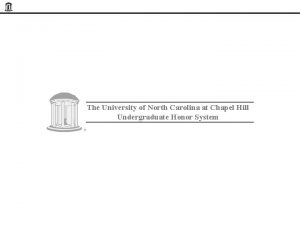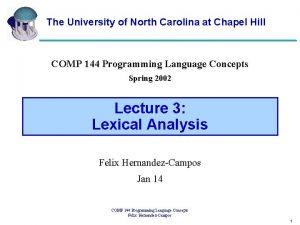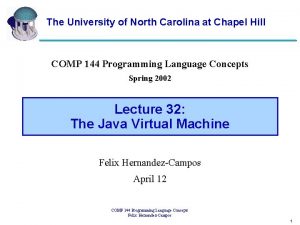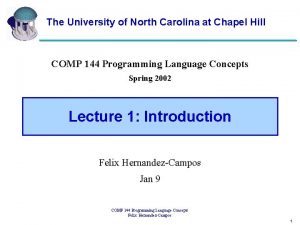University of North Carolina at Chapel Hill Models3
















- Slides: 16

University of North Carolina at Chapel Hill Models-3 Adel Hanna Carolina Environmental Program University of North Carolina at Chapel Hill Carolina Environmental Programs

University of North Carolina at Chapel Hill Regulatory or Policy User l l Need to identify source of a problem, contributing factors, and methods of controlling or alleviating pollutant emissions Need to understand the relative effectiveness of different controls and potential ramifications of proposed strategies Carolina Environmental Programs

University of North Carolina at Chapel Hill Science User l l l Seek to understand the physical-chemical system, how pollutants are produced, what processes are most important, and pollutant interact Non trivial problem especially with processes that are complex and non linear Evaluation (how well the model is representing the real world) Carolina Environmental Programs

University of North Carolina at Chapel Hill Models-3 Concepts l One Atmosphere • • • l One Modeling System • • • l Description of the atmospheric System Multi-scale Multi-pollutant Flexible and expandable Modular Analysis tools and Data handling One Community • • • Open Source Multi-user Platform for multiple contributions Carolina Environmental Programs

University of North Carolina at Chapel Hill Models-3 Modeling Components l l Three Main Components Sparse Matrix Operator Kernel Emissions (SMOKE) Community Multi-scale Air Quality Model (CMAQ) Meteorology Model (MM 5, ETA, RAMS, . . ) Carolina Environmental Programs

University of North Carolina at Chapel Hill Models-3; a Vision to the Community Needs l l l l Utilization of HPCC advances towards environmental modeling and decision making Modular, extensible science implementation Analysis and visualization Package Flexible to address more comprehensive atmospheric pollution (PM, Visibility, Toxics) Multi-scale (Urban, Regional, hemispheric) Air Quality Forecast Link to Human Exposure, Ecosystem Carolina Environmental Programs

University of North Carolina at Chapel Hill Transport and Chemical Evolution of Sulfate at 850 mb Daily Average April 20, 1998 April 21, 1998 April 22, 1998 Carolina Environmental Programs

University of North Carolina at Chapel Hill Transport and Chemical Evolution of Ozone at 850 mb Daily Average April 21 April 22 April 23 Carolina Environmental Programs

University of North Carolina at Chapel Hill Six Day Back Trajectories Carolina Environmental Programs

University of North Carolina at Chapel Hill CMAS; Technology Transfer l l A vision of Community cooperation as means to improving our science understanding while sharing experiences in exercising models for regulatory purposes From research to application to outreach, CMAS center is to advance the community modeling paradigm through the establishment of a centralized resource to serve the members of the environmental modeling community Carolina Environmental Programs

University of North Carolina at Chapel Hill CMAS l l l Serve as a bridge between various segments of the community Foster the growth of the developer and user communities Serve as a clearinghouse of information Become a hub for education and training about modeling Develop and market the value of CMAS in order to become self-sufficient Carolina Environmental Programs

University of North Carolina at Chapel Hill CMAS Functions l Outreach • • l Developing the user community Promoting value Establish and foster collaborations Create Self Sufficiency Application Support • User Support • Training • Consultation and model applications Carolina Environmental Programs

University of North Carolina at Chapel Hill CMAS Functions (Cont. ) l Software Development • Plans for External Review, Tracking, and Documenting model versions • Maintaining model codes and Documentation • Model inputs and outputs l Research • Application Driven • Model testing, development and evaluation • Computational Research and development Carolina Environmental Programs

University of North Carolina at Chapel Hill Community Contribution l EPA role in supporting Models-3 and its Potential user Community – – l l Help Desk, training facilities (first year) Science development and CMAQ releases Model Evaluation CMAQ review External Advisory Committee Members of the community are developing and sharing new modules Carolina Environmental Programs

University of North Carolina at Chapel Hill CMAS 2003/04 l Outreach • • • l Research • • l Proposal on leading topics CMAQ Review Applications • • • l News letter Quarterly Annual workshop Participation in Conferences Training sessions CMAQ, SMOKE, MIMS Advanced Training Off site training Software Development • Protocol for coding standards Carolina Environmental Programs

University of North Carolina at Chapel Hill Summary l l l More than 600 active users representing different sectors of the environmental community More interactions and communications International Correspondence (Atmosphere has no boundaries) CMAQ and SMOKE are among the leading models being used for various modeling applications Improvements and developments continue Carolina Environmental Programs
 Computer science unc chapel hill
Computer science unc chapel hill Virginia, maryland, north carolina, south carolina, georgia
Virginia, maryland, north carolina, south carolina, georgia Map of north carolina and south carolina
Map of north carolina and south carolina Maryland, virginia, north carolina, south carolina, georgia
Maryland, virginia, north carolina, south carolina, georgia Virginia, maryland, north carolina, south carolina, georgia
Virginia, maryland, north carolina, south carolina, georgia Unc hematology oncology fellows
Unc hematology oncology fellows Consenso de chapel hill
Consenso de chapel hill Enrolled agent chapel hill, nc
Enrolled agent chapel hill, nc Clasificacion chapel hill vasculitis 2012
Clasificacion chapel hill vasculitis 2012 Unc ohre
Unc ohre Unc chapel hill ib credit
Unc chapel hill ib credit Connect carolina
Connect carolina North carolina state university
North carolina state university North carolina sunshine laws
North carolina sunshine laws North carolina's state motto
North carolina's state motto Nc victim assistance network
Nc victim assistance network Packingham v. north carolina significance
Packingham v. north carolina significance
